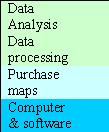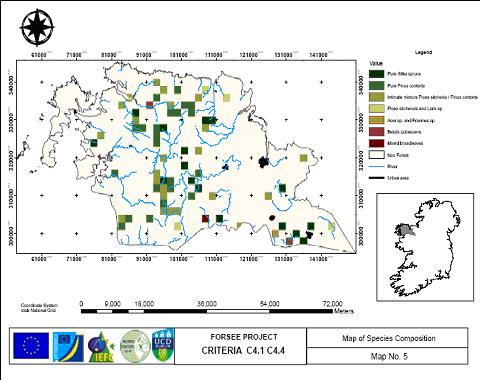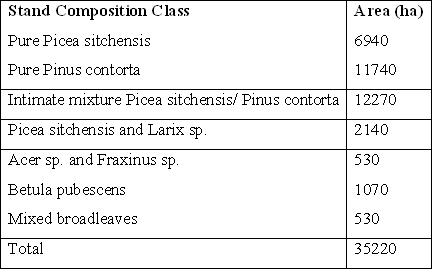Costs
Total Cost €4782
Shared Cost €4500
Marginal Cost €282
Total Cost/ha €0.14
These cost include:
Results
Table 4.1: Tree Species Composition in the Pilot Zone
Source: NFI data 2005
Remarks
Tree species composition in the pilot zone is dominated mainly by exotic conifers. These exotic conifers account for some 93% of the species area of the pilot zone. Pure Pinus contorta stands and intimate mixtures of Pinus contorta and Picea sitchensis account for 68% of the tree species composition in the pilot zone and this, as referred to in indicator 3.2, would be indicative of the poor productive capacity of the peat soils planted in the pilot zone.
Ireland’s forest cover was reduced to 1% of the total land area at the turn of the 20th century. To redress this situation a state forestry programme was initiated in 1907 to recreate a forest resource that would provide a sustainable supply of home grown timber. In 1904 planting trials were established at the Avondale estate in County Wicklow where over 40 different native and non-native species were established. It was on the basis of these trials that the advantages of introduced tree species, particularly conifers from the Pacific Northwest were proven (Horgan et al, 2004). The use of introduced tree species has permitted the establishment of forests on sites and under conditions that would have not been possible with the limited number of native Irish tree species. In 1948 the Irish government initiated an afforestation programme with a target of planting 10,000 hectares per year (Hickie, 1990). However, government policy at the time stated that land fit for agricultural purposes was not desirable for acquisition for afforestation. A maximum price was fixed at such a figure as to render its sale to the department as an uneconomic transaction (Farrell, 1983). This limit pushed the afforestation of land to the mainly infertile blanket peat on hill land and along the western seaboard. Picea sitchensis proved to be the most successful introduced tree species, best adapted to the poor soils and climate, while at the same time producing a quality white wood with many end uses. It was so successful that it formed 85% of the annual planting programme in the early 1990’s and composed 57% of the national forest estate in 2001 (Horgan et al, 2004). Pure stands of Picea sitchensis in the pilot zone are smaller than the national average at just 20%. This is reflective of the poor nature of the soils in the pilot zone which were more suited to pure stands of Pinus contorta (33%) or in intimate mixture with Picea sitchensis (35%). The mixed broadleaves stands in the pilot zone are composed of both native and non-native tree species. Only stands of Betula pubescens, which account for 3% of the species area, could be classified as not being introduced. Approximately 21% of the national forest estate is estimated to be broadleaves.
Problems and Improvements
Remarks and Conclusions
Conservation of the natural environment is very important and in recent years Irish forestry has made many changes in order to enhance biodiversity at both local and regional level. This was notable in 1996 when the Forest Service introduced a requirement that at least 20% of all afforestation sites must be planted with diverse species (i.e. other than Picea sitchensis and Pinus contorta); that all afforestation sites must leave 15% of the site area for biodiversity enhancement (open spaces, habitats, scrub areas) and that 10% of the site area should be afforested with broadleaves where appropriate (Anon, 2003). The Forest Biodiversity Guidelines (Anon (c), 2000) describes a range of measures intended to cover all situations relating to forestry and biodiversity and how best to conserve and enhance biodiversity in Irish forests through appropriate planning, conservation and management.

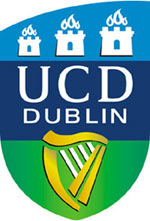
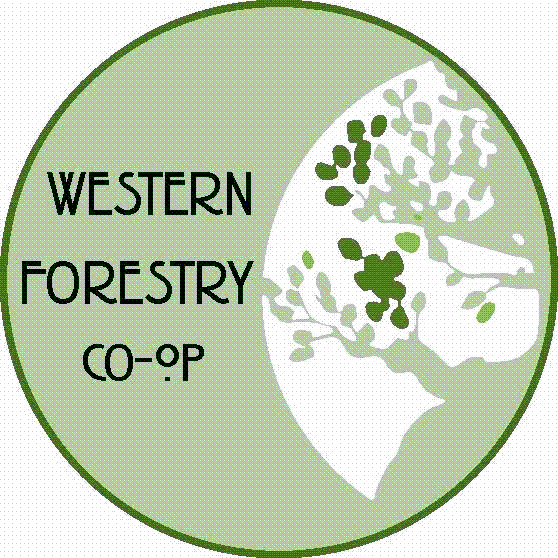
A community initiative ERDF
INTERREG the IIIB Atlantic Area
